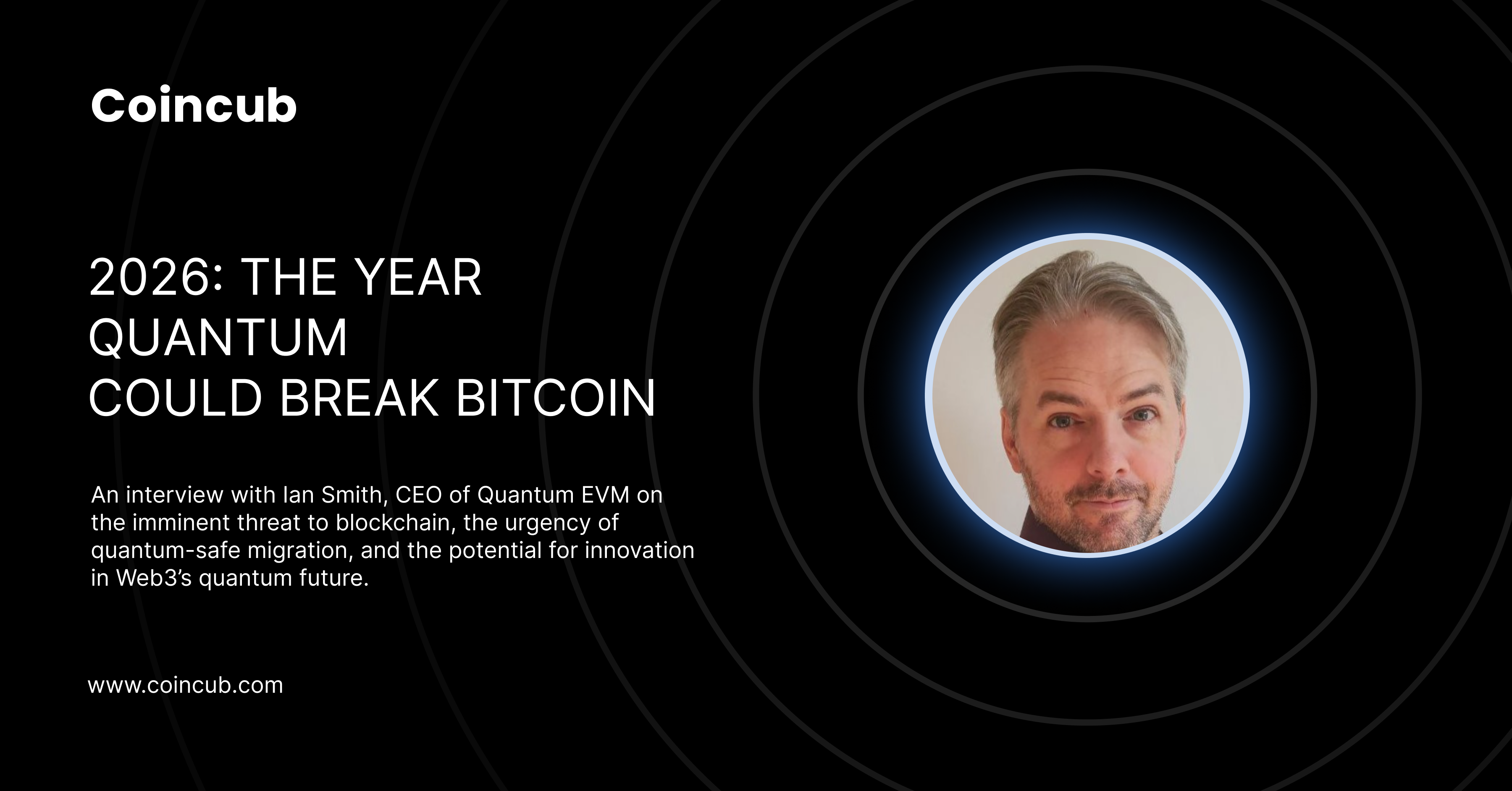2026: The Year Quantum Could Break Bitcoin

- QDay expected by 2026-2027, threatening blockchain security
- 20-30% of Bitcoin supply at risk from quantum attacks
- Blockchain’s decentralized nature complicates quantum-safe transition
In the heart of an office buzzing with innovation and urgency, Ian Smith, CEO of Quantum EVM, leads a mission that could redefine Web3 as we know it. Amid the technical discourse, Ian’s personality shines through. “Back-to-back meetings?” I ask, eyeing the quick walking tour he does to the office. Ian grins, “When juggling quantum computing and Web3, every day is a sprint.”
Behind him, whiteboards overflow with formulas and diagrams. As the face of Quantum EVM, Ian is battling the complexities of Web3 security and preparing for the seismic shift quantum computing threatens to bring.
“Let’s dive in,” Ian says, settling into a quiet space. “The quantum revolution isn’t a hypothetical anymore—it’s an impending reality, and Web3 must be ready.”
A Path of Self-Study and Expertise
Smith’s journey into quantum computing and cryptography is as unconventional as impressive. “I started with ‘Applied Cryptography’ in 1999,” he recalls. “In 2002, I worked through RSA procedures by hand to truly understand them. Doing RSA on paper is daunting but invaluable.”
He chuckles, adding, “The same can be said for a Keccak sponge or an AES S-box, but you’d need a few extra weeks for that crash course.”=
Smith acknowledges the evolving landscape of cryptography. “It used to be one book and a few disciplines. Now, with zero-knowledge proofs, fully homomorphic encryption, lattices, and the rapid changes in blockchain and quantum computing, it’s too vast for any single person to master completely.”
He emphasizes the importance of collaboration and trusting experts. “I tend to rely more on experts like Pierre-Luc Dallaire-Demers for quantum and trust Daniel Bernstein’s work to evaluate the NIST post-quantum candidates honestly.“
What is Quantum? A Revolution in Problem Solving
“Classical computing is like flipping light switches—on or off, 0 or 1,” Ian begins, breaking down the fundamental difference. “Quantum computing is like juggling 30 balls in the air, each representing a complex physics problem. While classical computers follow linear steps, quantum systems can solve multiple high-level problems simultaneously.”
At its core, quantum computing leverages two mind-bending principles of quantum mechanics: superposition and entanglement. Superposition allows quantum bits, or qubits, to exist in multiple states simultaneously—imagine a coin spinning mid-air, simultaneously heads and tails. Entanglement connects qubits so profoundly that a change in one instantly affects the other, even if they are miles apart.
Ian draws a metaphor to explain its power: “Imagine a classical computer as a diligent librarian, scanning every page of a book sequentially to find a word. A quantum computer, by contrast, reads the entire book instantly, spotting every occurrence of the word in one glance.”
Quantum computing isn’t just about doing things faster—it’s about solving problems that are impossible for classical computers to tackle in any reasonable timeframe. These include tasks like simulating new materials at the molecular level, optimizing global supply chains, or, as Ian warns, breaking cryptographic algorithms that secure modern technologies.
“Think of it like this,” Ian adds. “Classical computers are calculators. Quantum computers are the laws of physics encoded in a machine. They’re not just better—they’re fundamentally different.”
The Quantum Threat
The discussion begins with QDay, the anticipated moment when quantum computers surpass current cryptographic standards. Ian doesn’t sugarcoat the risks: “Quantum computing is no longer a distant concept. By 2026 or 2027, we expect quantum machines capable of breaking elliptic curve cryptography (ECC)—the backbone of blockchain security. The implications are catastrophic.”
Ian breaks it down with clarity. “Shor’s Algorithm is the primary weapon here. It allows quantum computers to reverse-engineer private keys from public ones. For blockchain systems, attackers could potentially drain wallets, manipulate smart contracts, and compromise the foundation of decentralized trust.”
Ian elaborates on the breadth of the risk: “Approximately 20-30% of Bitcoin’s circulating supply—over 4 million BTC—could be exposed. It’s not just about stolen funds. Losing trust in the blockchain ecosystem could be even more devastating.”
Ian highlights a compelling and highly controversial scenario involving Satoshi Nakamoto’s coins, which have remained untouched since Bitcoin’s inception. These coins, estimated to contain over 1 million BTC, could be a prime target for quantum attacks, symbolizing the ultimate test and reward for whoever first breaks QDay.
“Satoshi’s coins are the holy grail,” Ian explains. “The moment those coins move, it’s an undeniable signal to the world that Bitcoin’s cryptographic security has been breached. This event would have ripple effects across the financial and tech industries, shaking confidence in blockchain technology.”
Who Will Break QDay First? The Three Main Scenarios.
Ian articulates three distinct scenarios, each with profound implications for the blockchain ecosystem:
-
The NSA/CIA Break QDay
U.S. intelligence agencies were first to achieve quantum supremacy first
The NSA or CIA would likely not publicize their success. Instead, they would quietly address vulnerabilities by pressuring companies and institutions to upgrade their systems to quantum-resistant cryptography.
Ian predicts this would result in a months-long, tightly controlled process of upgrading global financial and tech infrastructures. This approach would minimize public panic and preserve blockchain’s credibility, albeit with regulatory intervention to speed up upgrades.
This least disruptive scenario ensures a controlled and systematic transition to quantum-resistant cryptography across industries.
-
A Private Company Breaks QDay
A tech giant or a quantum-focused startup achieving QDay is a darker scenario.
Stealing Satoshi’s Coins: The company could steal Satoshi Nakamoto’s BTC stash, sparking chaos in the crypto world. Ian explains, “They could either quietly sit on the stolen coins or use the event as a publicity stunt, demonstrating their quantum capabilities to attract clients and investment.”
Publicizing the breach would cement their position as a leader in quantum computing. Ian notes, “Their IPO valuation could skyrocket into the hundreds of billions, with customers lining up to access their technology.” While immensely profitable for the company, such an act would damage Bitcoin’s reputation and cause market-wide chaos.
It is a chaotic yet profitable scenario where bitcoin’s value and trust plummet, but quantum technology gains credibility and investment.
-
China Breaks QDay
Ian is particularly concerned about China’s potential to break QDay.
As China’s economy declines and capital flight continues to drain wealth via Bitcoin, the government has a strong incentive to neutralize the cryptocurrency entirely. “Bitcoin is enabling billions to leave China’s economy, and stopping the bleeding would be a strategic priority,” Ian says.
If China achieves quantum supremacy, it could destroy Bitcoin by exposing its vulnerabilities, rendering it unusable and erasing trust in its network. Ian warns that this move would not only cripple Bitcoin but could also serve as a show of technological dominance, asserting China’s position in the global tech race.
This is the most catastrophic scenario for Bitcoin, with geopolitical implications and the potential for blockchain technology to face severe setbacks worldwide.
The Migration Dilemma
Despite the challenges, Ian sees quantum computing as a catalyst for innovation. “It’s an opportunity to rebuild Web3 on a quantum-safe foundation. Quantum EVM is at the forefront of this effort. We’re integrating post-quantum cryptography to create a clean, secure ecosystem free of legacy vulnerabilities.”
Ian highlights promising developments like lattice-based systems and fully homomorphic encryption. “These technologies allow us to compute on encrypted data without exposing it—a game-changer for privacy and security.”
He describes Quantum EVM’s ambitious roadmap, which includes testnet launches and industry partnerships. “We aim to lead by example, showing the Web3 community what’s possible with quantum-safe infrastructure.”
One of the thorniest challenges is the migration to quantum-safe systems. Ian outlines the complexities: “Every user must sign a transaction to move their assets to a new quantum-safe address. This isn’t just a technical hurdle—it’s a logistical and educational one.”
He warns of the consequences of inaction. “For Bitcoin, this migration should’ve started years ago. The longer we wait, the more value remains exposed. We’ve seen this happen before—15-20% of Bitcoin still operates under old schemes, leaving it vulnerable.”
He points to vulnerable sectors like DeFi platforms, multi-signature wallets, and smart contracts. “Layer 1 and 2 solutions reliant on cryptographic primitives like BLS or Shamir Secret Sharing are equally at risk. The broader ecosystem faces a systemic threat.”
Bridging Quantum and Blockchain
Ian emphasizes the need for a comprehensive approach to quantum security. “This isn’t just about patching vulnerabilities. It’s about rethinking the entire ecosystem—from wallets and exchanges to smart contracts and consensus mechanisms.”
He envisions a future where quantum-safe chains dominate the landscape. “The projects that prepare now will lead the next era of Web3. This is about more than survival—it’s about thriving in a post-quantum world.”
Ian’s candor extends beyond quantum computing. We discuss everything from the flaws in current blockchain governance to the socio-economic implications of decentralized finance. “Crypto has always been about solving real-world problems,” he reflects. “But to do that, we must get our house in order first.”
On the topic of stablecoins, Ian doesn’t mince words. “Tether is a ticking time bomb. The lack of liquidity in these systems could drag the entire ecosystem down before quantum becomes a threat.”
The Quantum Alliance, A Unified Front Against Imposters
As our conversation deepens, Smith reveals a crucial initiative in the fight against quantum threats. “We’ve formed the Quantum Alliance – a coalition of companies legitimately implementing post-quantum cryptography. Currently, it includes Cellframe, The QRL, QEVM, and lesser-known coins like Mochimo and Tidecoin.”
Smith’s tone grows serious. “We need this alliance to be larger and stronger to combat imposters and scams. Unfortunately, some of the biggest names in crypto haven’t implemented the necessary cryptography.”
He outlines the alliance’s inclusive approach. “If Bitcoin Core adopts BIP360 from CryptoQuick, they’d be invited to join. Even if a competitor to Bitcoin implements the required cryptography, we’d embrace them. Our review of over 30 companies revealed that too few have legitimate cryptographic solutions. This alliance is about protecting the entire ecosystem, not just individual projects.”
Ian advises Web3 developers and investors as our conversation winds down: “Start building quantum-resistant solutions now. Collaborate with experts in post-quantum cryptography. The window for action is closing fast.”
He pauses as if weighing the gravity of his words. “Quantum computing is forcing us to confront our vulnerabilities. But it’s also giving us a chance to innovate, collaborate, and build a more resilient Web3.”
Ian’s message is clear: the quantum era is coming, and Web3 must adapt. As he heads into his next meeting, his parting words echo in my mind: “Innovation thrives under pressure. The quantum challenge is daunting and an invitation to create a brighter, more secure future.”
This is more than a battle for Web3’s survival—it’s a fight for its potential. The industry may have found its most formidable ally in Ian Smith and Quantum EVM.
- Urgent need for quantum-safe migration in blockchain
- Quantum computing presents both risks and innovation opportunities
- Industry-wide collaboration crucial for smooth transition to quantum-resistant systems



